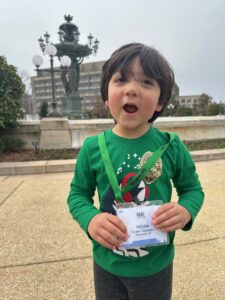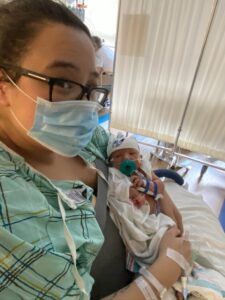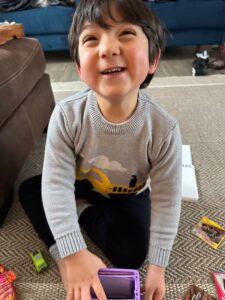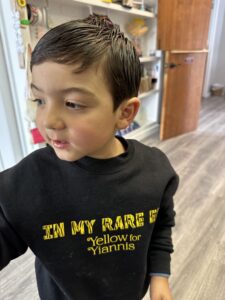
Rare Community Profiles is a Patient Worthy article series of long-form interviews featuring various stakeholders in the rare disease community, such as patients, their families, advocates, scientists, and more.
Yellow for Yiannis: Angela’s Mission to Advance Research into IRF2BPL
Three year old Yiannis Papazoglou’s personality is larger than life. When I recently met him at a dinner in Washington, D.C., he stoically cheers-ed the table with his glass of milk before grinning and whispering comments to his dad throughout dinner (at one point, Yiannis energetically whispered, “Dad, where are you from?!” in the middle of a conversation. “New York,” Chris replied with a laugh before adding, “I wonder where he got that question from.”).

Like many parents, Angela and Chris Papazoglou are absolutely enthralled by their son. Having met Yiannis, I can attest to his magnanimous nature. Angela describes him with a smile as:
“The most brave, empathetic, lovable child I’ve ever been around in my entire life. He’s just magic personified. There’s no other way to describe him. He just lights up the room. He’s got an amazing personality despite his obstacles and challenges. I wish I could bottle up his zeal and spray the universe and maybe it would be a better place for all of us.”
Right now, the parents soak up every last moment that they have with Yiannis; they live every day fully and presently, because they aren’t sure what will come next. When your child is facing an ultra-rare diagnosis like IRF2BPL, Yiannis’ rare disorder, it can be hard to have hope. But for Angela and Chris, hope is what drives them forward.

Currently, IRF2BPL is relatively unknown. There is little research, no targeted treatments, and no cure. It’s hard to even determine what the long-term effects of living with IRF2BPL may be. To Angela and Chris, getting to the bottom of these questions is crucial. As Angela explains:
“I cannot fathom life without him. We don’t know if we’ll have another child and, if we did, what if this happened again? If we didn’t and Yiannis passed away, I couldn’t survive. No matter what the scenario is, I can’t think about life without my child. We are just trying to be as transparent as possible, hope for the best, never take anything for granted, and develop something in the nick of time.”
Recently, Angela spoke with Patient Worthy about IRF2BPL, Yiannis’ experiences, and the necessity of additional research in the rare disease space.
Angela and Yiannis’ Story
On a blustery summer night in July 2020, Angela was induced to begin labor. Over the next 24 hours, she anxiously awaited the birth of her beautiful Yiannis. But one day passed, then two. After 72 hours in active labor, Yiannis wouldn’t descend any further. Doctors decided that it was time to perform an emergency C-section. They told Angela that Chris would not be allowed in the delivery room if she didn’t get an epidural. Instead, she begged them to sedate her fully.
Yiannis came into the world on a warm Saturday morning, weighing 7 pounds 5 ounces. His cord had been wrapped around his neck, shoulder, and arm. As she held him, Angela shares:
“I could tell that something was not right, but of course no mother wants to think that about their newborn. He was hypoxic because of the cord, which really upset me. The hospital had all the signs that something might be happening with me during labor, but they didn’t do an ultrasound. If they did, they would have known he was in distress. Obviously, his rare condition didn’t come about because of this but many of his other issues could have been mitigated if we got him out sooner.”

Thirty minutes after Yiannis was born, doctors whisked him away to the NICU. When Angela and Chris went to visit him, they noticed that the other neonates were screaming and crying—but not Yiannis. Says Angela:
“He was stoic, laying there, not really moving. Over the next two weeks, he didn’t really eat, didn’t emote, and had trouble breathing. Doctors were telling me that they thought he had meningitis or another infection even though I didn’t have an infection, so it made no sense to me. It was kind of terrifying.”
After two weeks, doctors finally decided that Yiannis was healthy enough to go home. But being discharged wasn’t necessarily a positive experience. Angela and Chris were concerned that Yiannis was rapidly losing weight. He was under five pounds when they were discharged and, despite being fed both breastmilk and formula around the clock, wasn’t growing at all. Looking back, Angela realizes how horrifying her experience was, noting:
“We had to get a legal team involved to get the hospital to give us our records. In red letters, it clearly says that they did not help our child at all. They knowingly discharged him without solving any of his issues in the NICU and without giving us any pointers on what to do.”
Yiannis soon dropped below four pounds. Almost every day, Chris and Angela found themselves visiting the pediatrician, trying to keep Yiannis out of the PICU. Angela says:
“He wouldn’t grow. Nothing stuck. He wasn’t emoting. He never cried, which is such a natural thing you wait for as a parent. He was diagnosed with a milk tolerance issue and switched to prescription formula. We dealt with bloody stool. In the middle of the pandemic, when my son should have been growing, he was still in premie diapers.”
Pursuing a Diagnosis
While Chris and Angela knew that there was some underlying cause for what was going on with Yiannis, their first concern was getting him to grow. They begged the pediatrician to start solids earlier, which the pediatrician agreed to. Breastmilk and prescription formula were mixed into hypoallergenic oatmeal; berries and spinach puree provided nutrients. Says Angela:
“Thank god that he started to grow after that. With the growth, we were hoping that he’d also hit more milestones. But he never crawled.”
Speech therapy, physical therapy, occupational therapy, feeding therapy: these became a mainstay of their day-to-day life as the parents fought to get Yiannis the tools he needed to function. His therapists and doctors told Angela and Chris that Yiannis had cerebral palsy. Angela says:
“We wanted to believe that was it. But deep down, we knew that we had to dig deeper to help him.”
Eventually, the family ended up visiting a neurologist who confirmed the parents’ suspicions. Something was going on with Yiannis, but the neurologist also shared that they had no idea what it was. A second neurologist found that Yiannis had full left side hypotonia and that he did not have cerebral palsy, though she did diagnose him with autism.
Soon after, the second neurologist recommended that Yiannis undergo whole exome sequencing to identify any genetic underpinnings. Just a few weeks later, Chris and Angela received a phone call from the lab. Angela shares:
“They were absolutely freaking out and told us that most kids with his condition don’t make it past ten years old, but that there wasn’t much other information they could give us.”
Dual Gene Mutations: IRF2BPL and ALMS1
The genetic testing found that Yiannis had mutations in his ALMS1 and IRF2BPL genes. ALMS1 is associated with a rare, inherited, multi-systemic condition called Alström syndrome. Currently, Yiannis does not show any signs of Alström syndrome, and the family isn’t sure how that will impact him in the future. Rather, IRF2BPL was their main concern. Says Angela:
“We were grateful for answers but horrified of the findings. We did copious amounts of testing before conception. Every test came back normal, which is why we decided to proceed. But we couldn’t have prevented this. Neither Chris nor I have the mutation. Yiannis’ case is de novo. Now that we’re here, we almost wish we had the mutation because we’d have hope that he could live into adulthood and not have the issues that coincide with IRF2BPL.”
Angela and Chris wanted to pursue second and third opinions. But they hit a roadblock: only certain labs can analyze Yiannis’ genes. Several labs said they could not isolate IRF2BPL, adding another complexity to the rare disease journey.

Further, there was not a ton of available information on IRF2BPL at the time of Yiannis’ diagnosis and, while research has uncovered some details, there is still a lack of understanding on how this condition might progress. This wasn’t good enough for Chris and Angela. Angela shares:
“We gave ourselves 48 hours to grieve and mourn what we saw as the future for our child, then dove into research. Scouring the web gave us no resources. There is one natural history study globally, so we immediately called them to see if we could get seen. Through our connections, we joined within three months. We also joined a Facebook support group but found that we wanted something more empowering and engaging. This led us to start our foundation and patient advocacy group, Yellow for Yiannis, to advance research into IRF2BPL. Every single day with Yiannis is a blessing and we will never stop working towards change.”
What Do We Know About IRF2BPL?
Yellow for Yiannis describes IRF2BPL-related disorders as progressive neurodevelopmental disorders with regression, abnormal movements, seizures, and loss of speech. The website explains that:
“Non-symptomatic people with these disorders at some point during their life span start to lose the ability to walk, talk, and eat. Over time, they require placement of a g-tube into the stomach to aid with feeding as well as a mechanical respirator to help them breathe. These symptoms are related to the broad spectrum of mutations in the IRF2BPL gene. The protein made by this gene is found in many different organs, including the brain. It is unclear how the protein made by this gene works in the body and why changes in the gene result in these disorders. The IRF2BPL gene may be involved in the regulation of other genes since IRF2BPL contains a special polyglutamine (polyQ) and polyalanine (polyA) tracts and such peptides are present in various forms of neurodegenerative diseases such as Huntington’s disease.”
Angela explains that IRF2BPL is thought to progress similarly to conditions like amyotrophic lateral sclerosis (ALS). Most children with IRF2BPL require a tracheostomy, are bed-bound, or use a wheelchair for mobility support. Additional symptoms and complications include aspiration and a loss of bowel control. The long-term outcome for children with IRF2BPL is unknown. However, it currently appears that many children with IRF2BPL pass away before age 10; Angela notes that this often occurs due to complications from an illness such as the flu or an opportunistic infection.
Right now, Chris and Angela have noticed that Yiannis’ difficulty swallowing has gotten more pronounced, with more frequent choking and gagging. Angela shares:
“We see things deteriorating and regressing. Our goal is to get him as strong as possible before the regression gets worse. We have hope even though some days, it’s really hard. It’s not fair to see him suffer. No child deserves to suffer like this. He’s had more surgeries and medical appointments than most adults have in their lifetime.”
At this time, Yiannis is the only person with his particular mutation. Says Angela:
“We met another family whose child is on the severe end of the disorder. If we don’t develop a therapy or cure, we know what lies ahead. So if there is anything we can do to mitigate it, we will do it. Even if we’re just able to stop the regressions, that is something. We are working day in and day out to figure something out.”
Yellow for Yiannis

Through Yellow for Yiannis, Chris and Angela are working to transform the landscape for IRF2BPL and provide solutions to families in need. One research study they hope to advance is a collaborative IRF2BPL study; families can help by donating patient cells. If you have questions on cell donation methods or procedures, you may contact Dr. Pawel Lisowski. Angela shares:
“Currently, there are only two researchers globally who are working to develop a viable treatment. We are so thankful for their work but are also looking for others who could lend their minds to this disorder. There have been so many shut doors because there are so few people with IRF2BPL. It has been a struggle to get people to want to help. We recognize that finding a cure may not happen in Yiannis’ lifetime, but we have to do our part in furthering research not just for him, but for the other children who are afflicted by this disorder. We know families who have been told, ‘Don’t have hope. Your child will have a hurtful, hard life before they pass.’ But I want to say – don’t lose hope. Science and medicine are changing every day.”
Since children with IRF2BPL have seizures, the foundation hopes to find ways to better monitor epilepsy and make EEGs less scary. Angela shares:
“For Yiannis, being on his back is the worst thing ever. I think it causes him pain. Seeing him have to be completely restrained for EEGs to put on hundreds of leads, multiple times, is traumatic for everyone involved.”
Yellow for Yiannis is currently in the queue to begin testing a live-time recording EEG wearable for easier seizure monitoring.
Outside of funding research and exploring wearables, Yellow for Yiannis is also committed to helping the broader community. Says Angela:
“95% of what we fundraise goes directly towards research, with the remaining 5% going towards need-based community members for equipment, travel, accommodations, and other resources. It has been amazing to help families. One of our community members is eight years old and in hospice. Medicaid kept denying the family’s request for a custom car seat to travel to and from appointments. The father had to sit in the back seat and hold his son’s neck up so he didn’t choke and aspirate. They applied and we were able to get them the car seat in less than a week.”
In the end, Angela wants to build a rare tribe and to help families affected by rare disease. Navigating a rare disease is incredibly difficult and isolating, but, she says:
“Rare isn’t all that rare. I’m so thankful for the people I’m here with. It’s such a blessing.”
Want to help make a difference? You can donate to Yellow for Yiannis here. If you are a researcher who is interested in studying IRF2BPL, please consider reaching out to Yellow for Yiannis directly by emailing [email protected]. The IRF2BPL community is particularly interested in research into drug repurposing or gene therapy.


